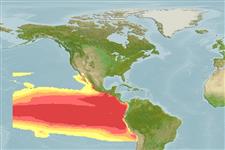(كوسه ها و سپرماهيان) (sharks and rays) >
Myliobatiformes (Stingrays) >
Mobulidae (Devilrays)
Eponymy: Walter Heinrich Munk (1917–2019) was an Austrian-born American oceanographer. [...] (Ref. 128868), visit book page.
Environment: milieu / climate zone / تغييرات عمق / distribution range
بوم شناسي
دريايي pelagic-oceanic; اقیانوس رو (Ref. 51243); تغييرات عمق 0 - 15 m (Ref. 58018). Tropical; 32°N - 7°S, 114°W - 77°W (Ref. 114953)
Eastern Pacific: From Gulf of California to Peru, incl. the Galapagos Is. (Ref. 130539).
Size / Weight / سن
بلوغ: Lm ? range ? - ? cm
Max length : 220 cm WD جنس نر / بدون خواص جنسي; (Ref. 28023); common length : 100.0 cm WD جنس نر / بدون خواص جنسي; (Ref. 9256)
Pelagic species forming schools in coastal and oceanic waters, but also found near the bottom. Found singly, in small groups, or in schools (Ref. 12951). Feeds mainly on planktonic crustaceans, but also takes small schooling fishes (Ref. 12951). Ovoviviparous (Ref. 50449). Gestation period unknown (Ref. 114953).
Life cycle and mating behavior
بلوغ | تولید مثل | تخم ریزی | تخم ها | Fecundity | توزاد ( لارو)
Exhibit ovoviparity (aplacental viviparity), with embryos feeding initially on yolk, then receiving additional nourishment from the mother by indirect absorption of uterine fluid enriched with mucus, fat or protein through specialised structures (Ref. 50449).
McEachran, J.D. and G. Notarbartolo di Sciara, 1995. Mobulidae. Mantas, diablos. p. 759-764. In W. Fischer, F. Krupp, W. Schneider, C. Sommer, K.E. Carpenter and V. Niem (eds.) Guia FAO para Identification de Especies para los Fines de la Pesca. Pacifico Centro-Oriental. 3 Vols. FAO, Rome. (Ref. 9256)
وضعيت در فهرست قرمز IUCN (Ref. 130435: Version 2025-1)
خطر برای انسان ها
Harmless
استفاده انسانی
ماهي گيري – شيلات: تجاري
ابزارها
گزارش های ويژه
بارگيری XML
منابع اينترنتي
Estimates based on models
Preferred temperature (مرجع
123201): 22.2 - 28.5, mean 23.5 °C (based on 368 cells).
Phylogenetic diversity index (مرجع
82804): PD
50 = 0.5039 [Uniqueness, from 0.5 = low to 2.0 = high].
Bayesian length-weight: a=0.01000 (0.00244 - 0.04107), b=3.04 (2.81 - 3.27), in cm total length, based on all LWR estimates for this body shape (Ref.
93245).
Trophic level (مرجع
69278): 3.8 ±0.60 se; based on food items.
جهندگی (مرجع
120179): پايين ، كم, كمينه زمان لازم براي دو برابر شدن جمعيت 5/4 – 14 سال (Fec assumed to be <100).
Fishing Vulnerability (Ref.
59153): Very high vulnerability (84 of 100).
🛈
